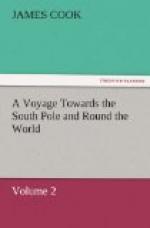Having spent the night lying-to, on the 12th, at day-break, we bore away, and steered east northerly, with a fine fresh breeze at W.S.W.; at noon observed in latitude 54 deg. 28’ S., longitude in 42 deg. 8’ W.; that is, near 3 deg. E. of the situation in which Mr Dalrymple places the N.E. point of the gulph of St Sebastian; but we had no other signs of land than seeing a seal and a few penguins; on the contrary, we had a swell from E.S.E., which would hardly have been, if any extensive track of land lay in that direction. In the evening the gale abated, and at midnight it fell calm.
The calm, attended by a thick fog, continued till six next morning, when we got a wind at east, but the fog still prevailed. We stood to the south till noon, when, being in the latitude of 55 deg. 7’, we tacked and stretched to the north with a fresh breeze at E. by S. and E.S.E., cloudy weather; saw several penguins and a snow-peterel, which we looked on to be signs of the vicinity of ice. The air too was much colder than we had felt it since we left New Zealand. In the afternoon the wind veered to the S.E., and in the night to S.S.E., and blew fresh, with which we stood to the N.E.
At nine o’clock the next morning we saw an island of ice, as we then thought, but at noon were doubtful whether it was ice or land. At this time it bore E. 3/4 S., distant thirteen leagues; our latitude was 53 deg. 56’ 1/2, longitude 39 deg. 24’ W.; several penguins, small divers, a snow-peterel, and a vast number of blue peterels about the ship. We had but little wind all the morning, and at two p.m. it fell calm. It was now no longer doubted that it was land, and not ice, which we had in sight. It was, however, in a manner wholly covered with snow. We were farther confirmed in our judgement of its being land, by finding soundings at one hundred and seventy-five fathoms, a muddy bottom. The land at this time bore E. by S., about twelve leagues distant. At six o’clock the calm was succeeded by a breeze at N.E., with which we stood to S.E. At first it blew a gentle gale; but afterwards increased so as to bring us under double-reefed top-sails, and was attended with snow and sleet.
We continued to stand to the S.E. till seven in the morning on the 15th, when the wind veering to the S.E., we tacked and stood to the north. A little before we tacked, we saw the land bearing E. by N. At noon the mercury in the thermometer was at 35 deg. 1/4. The wind blew in squalls, attended with snow and sleet, and we had a great sea to encounter. At a lee-lurch which the ship took, Mr Wales observed her to lie down 42 deg.. At half past four p.m. we took in the top-sails, got down top-gallant yards, wore the ship, and stood to the S.W., under two courses. At midnight the storm abated, so that we could carry the top-sails double-reefed.




